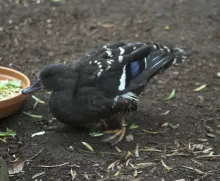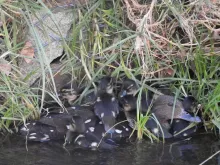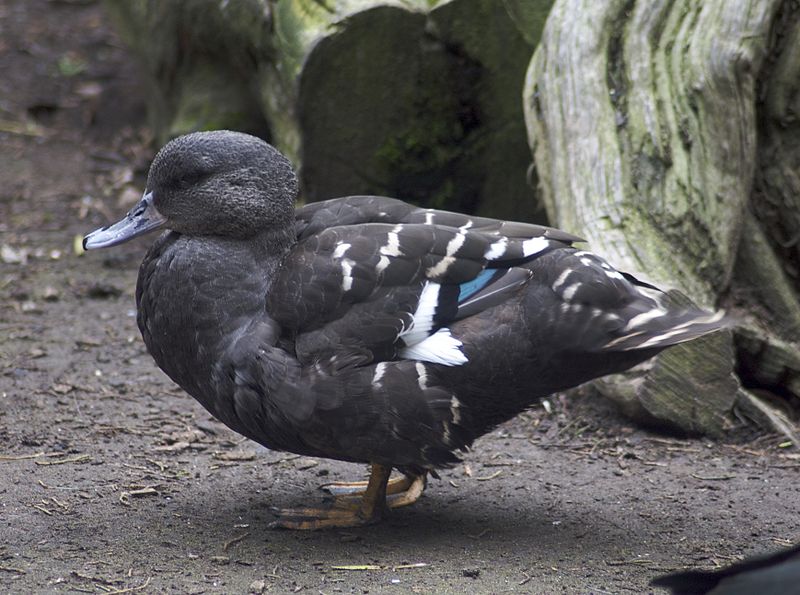
African Black Duck (Anas sparsa)
Species name
- Dutch name:
- Afrikaanse zwarte eend
- English name:
- African Black Duck
- German name:
- Schwarzente
- French name:
- Canard noir
- Scientific name:
- Anas sparsa
Scientific classification
- Order:
- Anseriformes
- Family:
- Anatidae
- Onderfamilie:
- Anatinae
- Genus:
- Anas
Description
- Description:
Male:
Overall body plumage dark brownish black. Head greyer-brown, with very slightly darker crown and lighter cheeks and throat (produced by very narrow buff edgings to feathers) really apparent only in fresh plumage. Sometimes has a whitish neck patch, which may meet to forum smudgy collar. Underparts slightly more olive–brown then upperparts; a few rear flank feathers barred buff(variable, and may extend to feathers on vent). Scapulars and tertails have broad buff bars, while uppertail-coverts and tail have narrower buff barring. In flight, upperwing dark brown on primaries, while secondaries form bluish iridescent speculum, boarded behind and in front by black and white bars; underwing converts much paler brown with white tips, contrasting with darker flight feathers; white tips to secondaries from whitish trailing edge. Bill pinkish-grey with black nail and black patch on upper mandible, sometimes extending over most the bill, though pinkish at base. Legs and feet yellow-orange with blackish blotching.Female:
looks Identical to male but smaller size apparent when in a pair. In some individuals female can appear darker black.Juvenile:
Not so dark brown as adults, with whitish belly with diffuse brown barring. Barring on underparts reduced or even absent at first. Speculum lacking iridescent. Bill grey Becomes as adult by the end of first year.
Standard Measurements
- Body Length (cm):
- The male (drake) of the African Black Duck measures approximately 50-55 centimeters. The female measures approximately 50-55 centimeters.
- Body Weight (grams):
- The male will weight about 1080 gram. The female will weight about 910 gram.
The weight is notoriously variable and can only be used as indication!
- Subspecies:
- Anas sparsa leucostigma: Abyssinian Black duck - Namibië and southern Zimbabwe to South-Africa.
- Anas sparsa sparsa: African Black Duck - Nigeria to Congo-Kinshasa, Soedan, Ethiopië, Zimbabwe and Angola.
- Habitat:
This species prefers fast-flowing shallow rivers and streams with rocky substrates, especially in wooded and mountainous environments. It can also be found in open, dry habitats and on lakes, reservoirs, lagoons, estuaries with sandy soils, stagnant or slow-running water and ponds.
- Note:
Dabbling Ducks are generally hardy, easy to maintain and easy to breed. Shelter may be required by some of the smaller species in winter. They should be provided with cover (including marginal pond cover) and loafing areas as well as water. A pen which is 50% water is suggested. The water may be shallow (i.e. no more than two feet deep is required), and muddy areas for dabbling in are also appreciated. These ducks are generally good in mixed collections, although the smaller and quieter species may be bullied. Territorial disputes between ducks of the same species may be avoided by keeping only one pair of each species in an enclosure, unless the area is very large. For a single pair of ducks a pen are of 50 to 100 square metres, depending on the size of duck, should be provided.
Most species are ground nesters and both close ground cover and ground level nest boxes should be provided. Hand-rearing is generally preferred, as these ducks are generally poor parents in captive conditions, particularly in enclosures shared with other waterfowl. These ducks are prone to hybridization, particularly with closely related species, which should be kept apart from one another.
African black ducks are territorial and aggressive, and can be secretive; a separate enclosure is suggested for a pair of these ducks. Cover and loafing areas should be provided as well as shallow water.
This species is difficult to breed. They use close ground cover or a ground-level nest box for breeding, and lays end of April to June.
- Breeding:
- The female African Black Duck usually lays from 4-8 brownish eggs and incubates them for 30 days.
- Artificial incubating:
The ideal relative humidity for incubating most waterfowl eggs is 55% (ground nesters) and 40% (cavity nesters). The temperature is usually 37.4°C. Set ventilation as recommended by the incubator manufacturer. Eggs must be turned, either automatically or by hand, a minimum of 4 times a day. As the duckling develops there is a loss of water from the egg and the air sac gets bigger. In normal development of an egg with a 30 days incubation, the air sac occupies about a third of it three days earlier. Cleanliness is vital and ideally eggs should be moved to a separate hatcher at this point, where the humidity should be increased to 65% and even higher once they have pipped internally.
- Bird banding:
- Recommended closed leg band ring size for the African Black Duck is 11 mm.The leg band ring can only be applied on a young duck at around 11-12 days old.
- It doesn't matter what leg that you band, but it's good to have a consistent system. Suggested: Left leg = Female, Right leg = Male
- Rearingfeed:
-
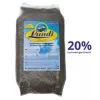
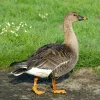

Floatable special rearing feed for all types of aquatic ornamental fowl - especially for the cultivation of trees as well as greening ducks.
This well-balanced complete feed with 20% protein content convinces above all by its good compatibility and forms the basis for visibly healthy growth from day one.
Made exclusively from wholesome and selected raw materials, Lundi Micro Regular is also ideally suited for the year-round feeding of waterfowl.
- Maintenance food:
-



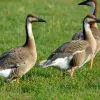

Lundi Regular with a protein content of 20%, valuable Spirulina and high-quality by-products is optimally balanced in its composition maintenance food for water ornamental fowl of all kinds. Especially green teal and Whistling ducks that are not dependent on a very high protein content, are well supplied.
Lundi Regular contains all the minerals and vitamins in full form that are important for the animals. Therefore also suitable as breeding food.


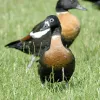


Floating full food for all sea ducks, green ducks, eider ducks and geese, especially in the moulting and breeding phase ideally suited. Packed with wholesome raw materials, natural vitamins and trace elements, this performance food with a protein content of 30% forms the basis for lifelong vitality.
